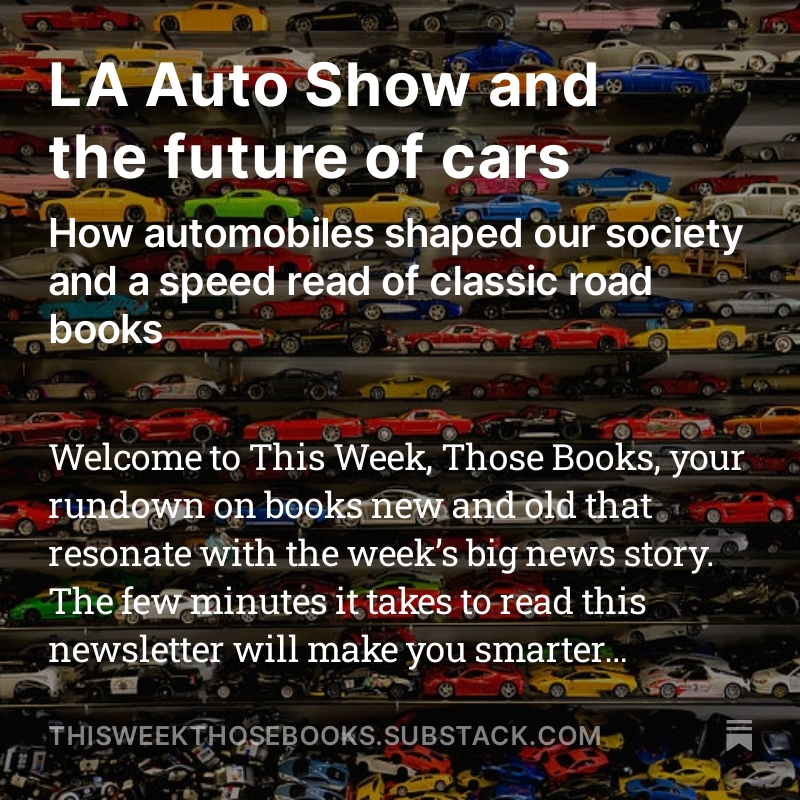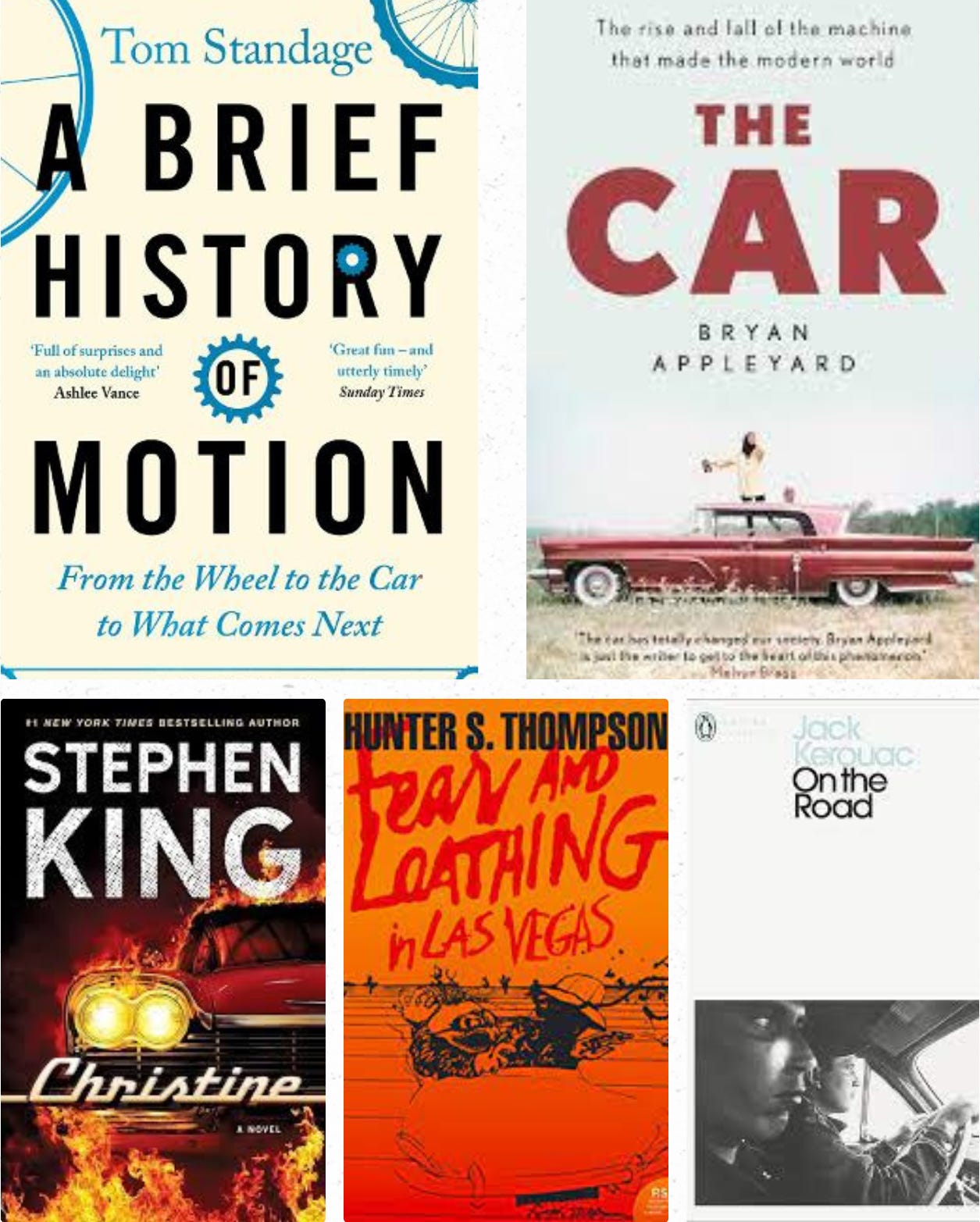LA Auto Show and the future of cars

Here’s the full version of the Nov22 This Week, Those Books. Sign up for free at https://thisweekthosebooks.com/ and get the post the day it drops
Welcome to This Week, Those Books, your rundown on books new and old that resonate with the week’s big news story.
The few minutes it takes to read this newsletter will make you smarter, faster. If you’d rather listen, click on the audio button above for a human, not AI, voiceover by my close collaborator Michael. These book suggestions – complete with summary, quotes and a visceral response rating – could point you to your next read or sort out watercooler convo and supper small talk. Please share. Find me on Twitter, LinkedIn, Facebook or YouTube.
Yours,

The Big Story:
The Los Angeles Auto Show, one of the biggest on the global motoring calendar for 116 years, is underway but with fewer new models. Like Detroit, once America’s leading motor event, LA and other auto shows face an uncertain future. By some accounts, so does their signature product. The car is driving into difficult terrain. Consider this:
- Anti-car policies have been gaining ground in many cities around the world, notably London, Paris, Milan, Hamburg, Copenhagen, Berlin, New York, Oklahoma City, Lancaster (California), Singapore, New Delhi, Kampala, Addis Ababa and Kigali.
- In America, the country most shaped by the car, fewer teens in the 16 to 19 age group have driving licenses.
- Concerns about climate change and pollution are spurring many people, particularly the young, to campaign against car-focussed development. Other reasons include the rise of online shopping, home film streaming, precarious employment, ride-sharing apps and car-sharing fleets.
- The automotive industry’s future is now thought to lie in electric vehicles (EVs), self-driving cars (AVs) and even flying cars that don’t require a pilot’s licence.
The Backstory:
- The car has had a good run since Carl Benz invented his “horseless carriage” in Mannheim, Germany in 1885.
- The Paris Motor Show, the first in the world, started in 1898.
- In America, meanwhile, by 1898, more than 100 companies were getting ready to manufacture automobiles.
- The Ford Motor Company, founded in 1903, led the automobile revolution with its affordable Model T.
- By the mid-1920s, America was a country on wheels. That same year also saw the emergence of the great European producers – Austin, Morris and Singer in England, Fiat in Italy, and Citroën in France.
- After World War II, many American cities replaced their walkable neighbourhoods with highways, parking lots and car-centric infrastructure. It became an urban design template for many parts of the world.
This Week, Those Books:
- A riveting survey of how cars shaped our society.
- A loving look at the significance of the automobile.
- Three road books featuring cars.

- A Brief History of Motion: From the Wheel to the Car to What Comes Next
By: Tom Standage
Publisher: Bloomsbury
Year: 2021

The Economist’s deputy editor charts a sure-footed course through the story of human transportation. He starts with the wheel, not invented in Mesopotamia apparently, but in the Carpathian Mountains of western Ukraine. Moving on to chariot, horse, coach and railway, he covers such oddities as the Laufmaschine, literally, ‘running machine’, which had no pedals and was the forerunner of the modern bicycle. Finally, the automobile, a French word introduced into the English language. It arrived in time “to liberate cities from the tyranny of the horse” and growing numbers of smelly manure dumps (14 in New York City by 1870). But cars no longer live up to their promise of freedom and “the world is now at, or has passed ‘peak car’, the point at which car ownership and use level off and decline.” The book suggests that “postcar era” transport options could be a mix of buses, trains, trams, taxis, ride hailing, car clubs, bike sharing and scooters, all accessed and paid for via a single app.

- The Car: The Rise and Fall of the Machine That Made the Modern World
By: Bryan Appleyard
Publisher: Weidenfeld & Nicolson
Year: 2022

It’s always a treat to read a fine writer and veteran journalist Bryan Appleyard is one of the finest. He examines the glory years of the car after the age of “equine traffic jams” and horse excrement on city streets – 500 tons a day in London by 1900! Cars, he writes, “have permanently changed our understanding of space, time and nature…they are the ultimate prosthetics, extending human capabilities.”
Choice quote:
“Within a few years owning a car might seem as eccentric as owning a train or a bus. Or perhaps it will simply be illegal.”

- Three road classics

- In Stephen King’s 1983 novel Christine, two high-schoolers buy a 1958 Plymouth Fury named Christine who has a mind of her own – and a demon instinct for murder.
- Hunter S Thompson’s 1971 Fear and Loathing In Las Vegas features a Chevy convertible nicknamed The Great Red Shark. It’s big and loud, symbolises the American Dream and the protagonist Raoul Duke uses it to hurtle through the Nevada desert.
- Jack Kerouac’s 1957 On the Road has the author’s fictionalised persona, Sal Paradise, travelling around in a Cadillac, a Hudson Commodore and a Ford Sedan, on a road trip for the ages.




